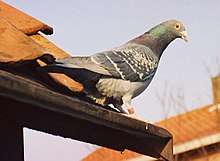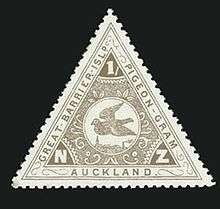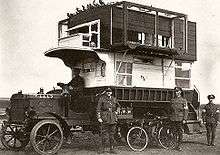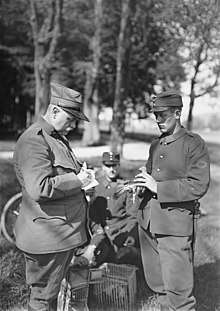Homing pigeon
The true messenger pigeon is a variety of domestic pigeons (Columba livia domestica) derived from the wild rock dove, selectively bred for its ability to find its way home over extremely long distances. The rock dove has an innate homing ability,[1] meaning that it will generally return to its nest (it is believed) using magnetoreception.[2] Flights as long as 1,800 km (1,100 miles) have been recorded by birds in competitive pigeon racing.[3] Their average flying speed over moderate 965 km (600 miles) distances is around 97 km/h (60 miles per hour)[4] and speeds of up to 160 km/h (100 miles per hour) have been observed in top racers for short distances.

Because of this skill, domesticated pigeons were used to carry messages as messenger pigeons. They are usually referred to as "pigeon post" if used in post service, or "war pigeon" during wars. Until the introduction of telephones, homing pigeons were used commercially to deliver communication.
Messenger pigeons are often incorrectly categorized as English Carrier pigeons, an ancient breed of fancy pigeons. They were used historically to send messages but lost the homing instinct long ago. Modern-day homing pigeons (homers) or racing pigeons (racing homers) do have "Carrier blood" in them because they are in part descendants of the old-style Carriers. This is one reason why they are still commonly but erroneously called "carrier pigeons".
History

By 3000 BC, Egypt was using homing pigeons for pigeon post, taking advantage of a singular quality of this bird, which when taken far from its nest is able to find its way home due to a particularly developed sense of orientation. Messages were then tied around the legs of the pigeon, which was freed and could reach its original nest. By the 19th century homing pigeons were used extensively for military communications.[5]
The sport of flying messenger pigeons was well-established as early as 3000 years ago.[6] They were used to proclaim the winner of the Ancient Olympics.[6][7] Messenger pigeons were used as early as 1150 in Baghdad[8] and also later by Genghis Khan. By 1167 a regular service between Baghdad and Syria had been established by Sultan Nur ad-Din.[9] In Damietta, by the mouth of the Nile, the Spanish traveller Pedro Tafur saw carrier pigeons for the first time, in 1436, though he imagined that the birds made round trips, out and back.[10] The Republic of Genoa equipped their system of watch towers in the Mediterranean Sea with pigeon posts. Tipu Sultan of Mysore (1750–1799) also used messenger pigeons; they returned to the Jamia Masjid mosque in Srirangapatna, which was his headquarters. The pigeon holes may be seen in the mosque's minarets to this day.
In 1818, a great pigeon race called the Cannonball Run took place at Brussels.[6] In 1860, Paul Reuter, who later founded Reuters press agency, used a fleet of over 45 pigeons to deliver news and stock prices between Brussels and Aachen, the terminus of early telegraph lines. The outcome of the 1815 Battle of Waterloo has often been claimed to have been delivered to London by pigeon but there is no evidence for this and it's very unlikely; the pigeon post was rare until the 1820s.[11] During the Franco-Prussian War pigeons were used to carry mail between besieged Paris and the French unoccupied territory. In December 1870, it took ten hours for a pigeon carrying microfilms to fly from Perpignan to Brussels.[12]
Historically, pigeons carried messages only one way, to their home. They had to be transported manually before another flight. However, by placing their food at one location and their home at another location, pigeons have been trained to fly back and forth up to twice a day reliably, covering round-trip flights up to 160 km (100 mi).[13] Their reliability has lent itself to occasional use on mail routes, such as the Great Barrier Pigeongram Service established between the Auckland, New Zealand, suburb of Newton and Great Barrier Island in November 1897,[14] possibly the first regular air mail service in the world. The world's first 'airmail' stamps were issued for the Great Barrier Pigeon-Gram Service from 1898 to 1908.[15]
Homing pigeons were still employed in the 21st century by certain remote police departments in Odisha state in eastern India to provide emergency communication services following natural disasters. In March 2002, it was announced that India's Police Pigeon Service messenger system in Odisha was to be retired, due to the expanded use of the Internet.[16] The Taliban banned the keeping or use of homing pigeons in Afghanistan.[17]
To this day, pigeons are entered into competitions.[18]
Navigation
Research has been performed with the intention of discovering how pigeons, after being transported, can find their way back from distant places they have never visited before. Most researchers believe that homing ability is based on a "map and compass" model, with the compass feature allowing birds to orient and the map feature allowing birds to determine their location relative to a goal site (home loft).[19] While the compass mechanism appears to rely on the sun, the map mechanism has been highly debated.[20] Some researchers believe that the map mechanism relies on the ability of birds to detect the Earth's magnetic field.
A prominent theory is that the birds are able to detect a magnetic field to help them find their way home. Scientific research previously suggested that on top of a pigeon's beak large number of iron particles are found which remain aligned to north like a man-made compass, thus it acts as compass which helps pigeon in determining its home. However, a 2012 study disproved this theory, putting the field back on course to search for an explanation as to how animals detect magnetic fields.[21]
A light-mediated mechanism that involves the eyes and is lateralized has been examined somewhat, but developments have implicated the trigeminal nerve in magnetoception.[22][23] Research by Floriano Papi (Italy, early 1970s) and more recent work, largely by Hans Wallraff, suggest that pigeons also orient themselves using the spatial distribution of atmospheric odors,[20] known as olfactory navigation.
Other research indicates that homing pigeons also navigate through visual landmarks by following familiar roads and other man-made features, making 90-degree turns and following habitual routes, much the same way that humans navigate.[24]
Research by Jon Hagstrum of the US Geological Survey suggests that homing pigeons use low-frequency infrasound to navigate.[25] Sound waves as low 0.1 Hz have been observed to disrupt or redirect pigeon navigation. The pigeon ear, being far too small to interpret such a long wave, directs pigeons to fly in a circle when first taking air, in order to mentally map such long infrasound waves.
Various experiments suggest that different breeds of homing pigeons rely on different cues to different extents. Charles Walcott at Cornell University was able to demonstrate that while pigeons from one loft were confused by a magnetic anomaly in the Earth it had no effect on birds from another loft 1.6 km (1 mile) away. Other experiments have shown that altering the perceived time of day with artificial lighting or using air conditioning to eliminate odors in the pigeons' home roost affected the pigeons' ability to return home.
GPS tracing studies indicate that gravitational anomalies may play a role as well.[26][27]
Roles
Postal carriage
When used as carrier pigeons in pigeon post a message is written on thin light paper and rolled into a small tube attached to the bird's leg. Pigeons can only go back to one "mentally marked" point that they have identified as their home, so "pigeon mail" can only work when the sender is actually holding the receiver's pigeons.
With training, pigeons can carry up to 75 g (2.5 oz) on their backs. The German apothecary Julius Neubronner used carrier pigeons to deliver urgent medication.[28] In 1977 a similar carrier pigeon service was set up for the transport of laboratory specimens between two English hospitals. Every morning a basket with pigeons was taken from Plymouth General Hospital to Devonport Hospital. The birds then delivered unbreakable vials back to Plymouth as needed.[29] The 30 carrier pigeons became unnecessary in 1983 because of the closure of one of the hospitals.[30] In the 1980s a similar system existed between two French hospitals located in Granville and Avranche.[31]
Wartime communication



Birds were used extensively during World War I. One homing pigeon, Cher Ami, was awarded the French Croix de guerre for her heroic service in delivering 12 important messages, despite having been very badly injured.[32]
During World War II, the Irish Paddy, the American G.I. Joe and the English Mary of Exeter all received the Dickin Medal. They were among 32 pigeons to receive this award, for their gallantry and bravery in saving human lives with their actions. Eighty-two homing pigeons were dropped into the Netherlands with the First Airborne Division Signals as part of Operation Market Garden in World War II. The pigeons' loft was located in London, which would have required them to fly 390 km (240 miles) to deliver their messages.[33] Also in World War II, hundreds of homing pigeons with the Confidential Pigeon Service were airdropped into northwest Europe to serve as intelligence vectors for local resistance agents. Birds played a vital part in the Invasion of Normandy as radios could not be used for fear of vital information being intercepted by the enemy.
Computing
The humorous IP over Avian Carriers (RFC 1149) is an Internet protocol for the transmission of messages via homing pigeon. Originally intended as an April Fools' Day RFC entry, this protocol was implemented and used, once, to transmit a message in Bergen, Norway, on April 28, 2001.[34]
In September 2009, a South African IT company based in Durban pitted an 11-month-old bird armed with a data packed 4 GB memory stick against the ADSL service from the country's biggest Internet service provider, Telkom. The pigeon, Winston, took an hour and eight minutes to carry the data 80 km (50 miles). In all, the data transfer took two hours, six minutes, and fifty-seven seconds—the same amount of time it took to transfer 4% of the data over the ADSL.[35][36]
Smuggling
Homing pigeons have been reported to be used as a smuggling technique, getting objects and narcotics across borders and into prisons.[37] For instance, between 2009 and 2015, pigeons have been reported to carry cell phones, SIM cards, phone batteries and USB cords into prisons in the Brazilian state of São Paulo.[38][39]
Animal exploitation
Pigeon races are sometimes considered as a type of animal exploitation and against animal welfare, particularly where betting is involved, and animal welfare is regarded as secondary. For example, the animal welfare organisation PETA criticises Taiwanese owners for flying birds across wide oceans where few reach their destination, claiming a fatality rate of 98%.[40]
See also
References
- Blechman, Andrew (2007). Pigeons-The fascinating saga of the world's most revered and reviled bird. St Lucia, Queensland: University of Queensland Press. ISBN 978-0-7022-3641-9. Archived from the original on 2008-01-12.
- Levi, Wendell (1977). The Pigeon. Sumter, S.C.: Levi Publishing Co. p. 82. ISBN 978-0-85390-013-9.
- Walcott, Charles (1996). "Pigeon Homing: Observations,copup and Confusions" (PDF). Journal of Experimental Biology. 199 (Pt 1): 21–27. PMID 9317262. Retrieved 2008-01-04.
- Andrew (2011). "Cairo's Fancy Fliers". Saudi Aramco World. Vol. 62 no. 2. Aramco Services Company. Retrieved 11 December 2018.
- Carter W. Clarke, "Signal Corps Pigeons." The Military Engineer 25.140 (1933): 133-138 Online.
- Teale, Edwin (June 1936). "Mile-a-Minute Pigeons". Popular Science Monthly. 128 (6): 25ff.
- Blechman, Andrew (2007). Pigeons — The fascinating saga of the world's most revered and reviled bird. St Lucia, Queensland: University of Queensland Press. ISBN 978-0-7022-3641-9.
- "The Sport of Racing Homing Pigeons". fbipigeons.com.
- Allatt, Captain H.T.W. (1886). "The Use of Pigeons as Messengers in War and the Military Pigeon Systems of Europe". RUSI Journal. 30 (133): 107–148 [111]. doi:10.1080/03071848609416366. Retrieved 24 November 2012.
- "I saw there for the first time carrier pigeons, which take letters in their tail-feathers. They carry them from the place where they are bred to other places, and when the letters are detached they are set free and return to their homes. By this means the inhabitants have speedy news of all who come and go by sea or land." (Pedro Tafur, Andanças e viajes).
- "Challenging the myth". Archived from the original on 2018-02-02. Retrieved 2017-02-02.
- Cardenas, Fabricio (4 May 2014). "Perpignan–Bruxelles par pigeon-express". Vieux papiers des Pyrénées-Orientales (in French). Retrieved 24 February 2016.
- National Research Council (1991). Micro Livestock — Little Known Small Animals With a Promising Economic Future. Sumter, South Carolina: Natl Academy Pr. ISBN 978-0-309-04437-0."Archived copy". Archived from the original on 2016-04-13. Retrieved 2015-06-21.CS1 maint: archived copy as title (link)
- "Carrier pigeons still serve; Even in modern war they do messenger duty". The New York Times. April 12, 1936. p. SM26.
- "The Great Barrier Island Pigeon-Gram Service". Museum of New Zealand Te Papa Tongarewa. Archived from the original on 2012-04-15.
- "Indian pigeons lose out to e-mail". BBC News Online. 2002-03-26. Retrieved 2010-03-27.
- "Some of the restrictions imposed by Taliban on women in Afghanistan". Revolutionary Association of the Women of Afghanistan. Retrieved 2008-01-03.
- "Beginners' Guide to Racing Pigeons". Pigeon Mad.
- Bingman, V. P. (1998). Spatial representations and homing pigeon navigation. In S. Healy (Ed). Spatial representation in animals. (pp. 67–85). Oxford: Oxford University Press.
- Wallraff, H.G. (2004). "Avian olfactory navigation: its empirical foundation and conceptual state". Animal Behaviour. 67 (2): 189–204. doi:10.1016/j.anbehav.2003.06.007.
- Treiber, CD; et al. (2012). "Clusters of iron-rich cells in the upper beak of pigeons are macrophages not magnetosensitive neurons". Nature. 484 (7394): 367–70. Bibcode:2012Natur.484..367T. doi:10.1038/nature11046. PMID 22495303.
- Mora, C. V.; Davison, M.; Wild, J. M.; Walker, M. M. (2004). "Magnetoreception and its trigeminal mediation in the homing pigeon". Nature. 432 (7016): 508–511. Bibcode:2004Natur.432..508M. doi:10.1038/nature03077. PMID 15565156.
- Gagliardo, A.; Ioale, P.; Savini, M.; Wild, J. M. (2006). "Having the nerve to home: trigeminal magnetoreceptor versus olfactory mediation of homing in pigeons". The Journal of Experimental Biology. 209 (15): 2888–2892. doi:10.1242/jeb.02313. PMID 16857872.
- "Pigeons reveal map reading secret". BBC News (5 Feb, 2004). 2004-02-05. Retrieved 2008-07-02.
- Knight, Kathryn (2013). Disappearing homing pigeon mystery solved. The Company of Biologists. Retrieved 2013-01-31
- Nicole Blaser; Sergei I. Guskov; Virginia Meskenaite; Valerii A. Kanevskyi; Hans-Peter Lipp (October 23, 2013). "Altered Orientation and Flight Paths of Pigeons Reared on Gravity Anomalies: A GPS Tracking Study". PLoS ONE. 8 (10): e77102. Bibcode:2013PLoSO...877102B. doi:10.1371/journal.pone.0077102. PMC 3806762. PMID 24194860.
- Nicole Blaser; Sergei I. Guskov; Vladimir A. Entin; David P. Wolfer; Valeryi A. Kanevskyi; Hans-Peter Lipp (2014). "Gravity anomalies without geomagnetic disturbances interfere with pigeon homing – a GPS tracking study". Journal of Experimental Biology. 217 (22): 4057–4067. doi:10.1242/jeb.108670. PMID 25392461.
- "Le pigeon voyageur photographe". Les Nouveautés Photographiques (in French): 63–71. 1910.
- Pigeons flying for life, The Milwaukee Sentinel – July 23, 1977
- "The Probe: Newsletter of the National Animal Damage Control Association, Issue 33 – June 1983". Retrieved 2013-08-14.
- "Le Carabinier" (PDF).
- Webley, Kayla (21 March 2011). "Top 10 Heroic Animals". Time Magazine. Retrieved 17 January 2017.
- Cornelius Ryan - A Bridge Too Far
- "RFC-1149". BLUG. Archived from the original on 2011-10-04.
- Govender, Peroshni (2009-09-09). "Pigeon transfers data faster than South Africa's Telkom". Reuters (September 9, 2009). Retrieved 2009-10-09.
- "SA pigeon 'faster than broadband'". BBC (September 10, 2009). 2009-09-10. Retrieved 2009-10-09.
- Quilty-Harper, Conrad. "Cocaine carrier pigeons are the latest drug smuggling technique". British GQ. Retrieved 2017-05-25.
- G1 São Paulo (April 28, 2009). "Pombo que levava celular para presos é capturado no interior de SP (Portuguese)". G1. Retrieved October 26, 2015.
- G1 São Paulo (August 4, 2015). "Pombo com celular é encontrado em penitenciária na Zona Sul de SP (Portuguese)". G1. Retrieved October 26, 2015.
- "Tell the Taiwanese Government to Ban Deadly Pigeon Races Over the Ocean!". support.peta.org. Retrieved Aug 2, 2020.
Further reading
- Lucy M Blanchard, Chico, the Story of a Homing Pigeon in the Great War, Diggory Press, ISBN 978-1-84685-039-4
- Carter W. Clarke, "Signal Corps Pigeons." The Military Engineer 25.140 (1933): 133-138 Online.
- Jon Day, "Operation Columba" (review of Gordon Corera, Secret Pigeon Service, William Collins, 2018, 326 pp., ISBN 978 0 00 822030 3), London Review of Books, vol. 41, no. 7 (4 April 2019), pp. 15–16. "Pigeons flew across theRoman Empire carrying messages from the margins to the capital. [In 43 BCE] Decimus Brutus broke Marc Antony's siege of Mutina [Modena, in northern Italy] by sending letters to the consuls via pigeon.... [However, p]igeons only really came into their own with modern [times, especially d]uring the 19th and early 20th centuries..." (Jon Day, p. 15.)
- Meir Shalev, A Pigeon and a Boy (English translation by Evan Fallenberg), a historical novel about the use of pigeons by the Israel Defense Forces (and the Haganah before Israel was founded in 1948) in the defence of Israel when it was first founded, and in the defence of the Jewish community before Israeli independence
- Jerry Spinelli, Wringer
- Tegetmeier, William Bernhard (1871). The homing or carrier pigeon. London: George Routledge.
- "Nine Champions Create A Champion", Bob Kinney Silverado, The Thoroughbred, 15 May 1998
External links
| Wikimedia Commons has media related to Homing pigeons. |
- Pigeon and Business and Communication
- The great pigeon race disaster of 97 suggests an answer to an enduring mystery, George Johnson, "ON SCIENCE", St. Louis Post Dispatch
- The System of Military Dovecotes in Europe from an 1891 Scientific American article at Project Gutenberg
- Joao Moreira Tavares: Carrier Pigeons (Portugal), in: 1914-1918-online. International Encyclopedia of the First World War.
- Resource for pigeon racers
- Round Trip War Birds, Popular Science, November 1941, article on US Army Signal Corps use of homing pigeons with first high-speed photos showing how a pigeon flies
- Fragment 'Those waiting for the birds' (2008, Eve Duchemin), documentary about Belgian homing pigeons
- Miller, James Nevin (February 1930). "The Passing of the Carrier Pigeon". Popular Mechanics: 194–197.